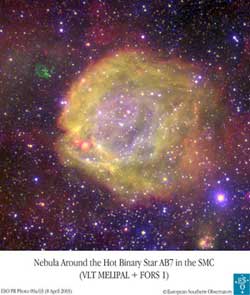Really Hot Stars

Nebula around the hot star AB7 in the SMC <br>photographed with the ESO VLT
Spectacular VLT Photos Unveil Mysterious Nebulae
Quite a few of the most beautiful objects in the Universe are still shrouded in mystery. Even though most of the nebulae of gas and dust in our vicinity are now rather well understood, there are some which continue to puzzle astronomers.
This is the case of a small number of unusual nebulae that appear to be the subject of strong heating – in astronomical terminology, they present an amazingly “high degree of excitation”. This is because they contain significant amounts of ions, i.e., atoms that have lost one or more of their electrons. Depending on the atoms involved and the number of electrons lost, this process bears witness to the strength of the radiation or to the impact of energetic particles.
But what are the sources of that excitation? Could it be energetic stars or perhaps some kind of exotic objects inside these nebulae? How do these peculiar objects fit into the current picture of universal evolution?
New observations of a number of such unusual nebulae have recently been obtained with the Very Large Telescope (VLT) at the ESO Paranal
Observatory (Chile). In a dedicated search for the origin of their
individual characteristics, a team of astronomers – mostly from the Institute of Astrophysics & Geophysics in Liege (Belgium) [1] – have
secured the first detailed, highly revealing images of four highly
ionized nebulae in the Magellanic Clouds, two small satellite galaxies of our home galaxy, the Milky Way, only a few hundred thousand light-years away.
In three nebulae, they succeeded in identifying the sources of energetic radiation and to eludicate their exceptional properties: some of the hottest, most massive stars ever seen, some of which are double.
With masses of more than 20 times that of the Sun and surface
temperatures above 90 000 degrees, these stars are truly extreme.
Media Contact
More Information:
http://www.eso.org/outreach/press-rel/pr-2003/pr-08-03.htmlAll latest news from the category: Physics and Astronomy
This area deals with the fundamental laws and building blocks of nature and how they interact, the properties and the behavior of matter, and research into space and time and their structures.
innovations-report provides in-depth reports and articles on subjects such as astrophysics, laser technologies, nuclear, quantum, particle and solid-state physics, nanotechnologies, planetary research and findings (Mars, Venus) and developments related to the Hubble Telescope.
Newest articles

High-energy-density aqueous battery based on halogen multi-electron transfer
Traditional non-aqueous lithium-ion batteries have a high energy density, but their safety is compromised due to the flammable organic electrolytes they utilize. Aqueous batteries use water as the solvent for…

First-ever combined heart pump and pig kidney transplant
…gives new hope to patient with terminal illness. Surgeons at NYU Langone Health performed the first-ever combined mechanical heart pump and gene-edited pig kidney transplant surgery in a 54-year-old woman…

Biophysics: Testing how well biomarkers work
LMU researchers have developed a method to determine how reliably target proteins can be labeled using super-resolution fluorescence microscopy. Modern microscopy techniques make it possible to examine the inner workings…





















